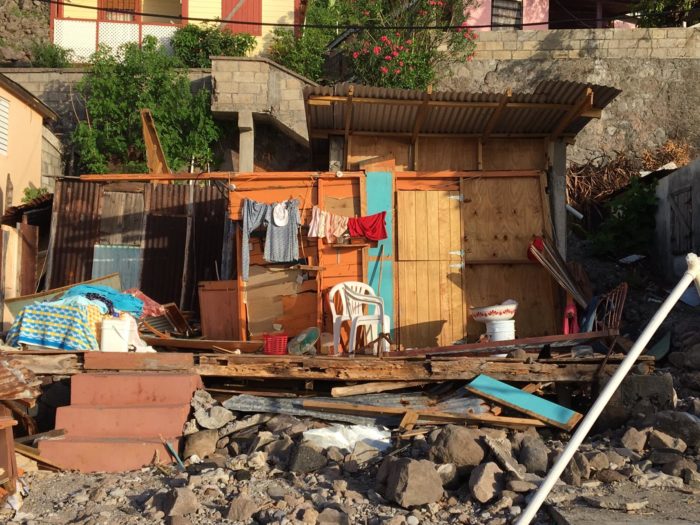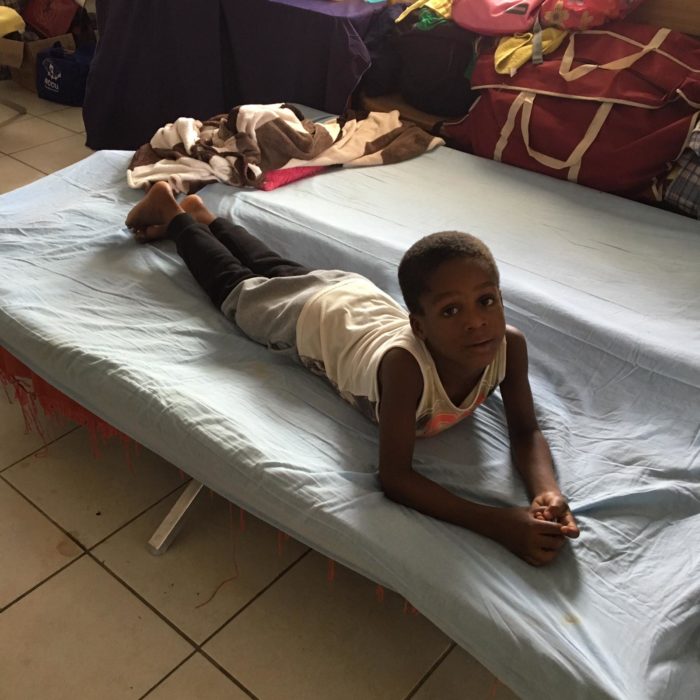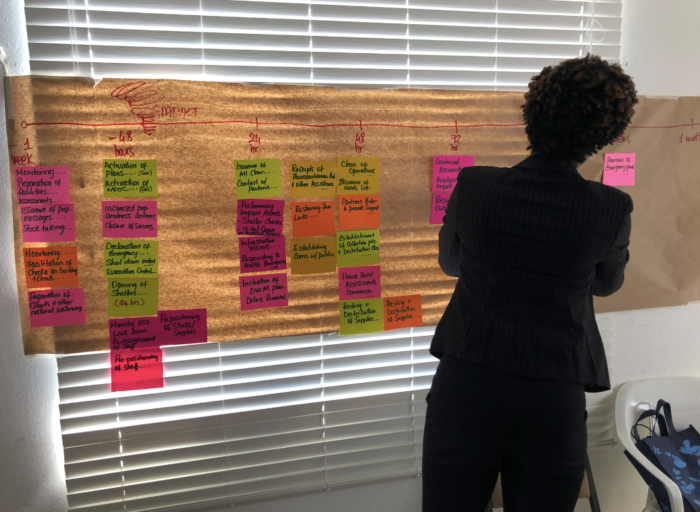Authors: Nick Grainger, Asha Williams, Kathryn Milliken and Francesca Ciardi
The increased intensity of hydro meteorological events in Caribbean countries in recent years has altered landscapes, damaged infrastructure, debilitated economies, and threatens to undermine development and growth. In the midst of these impacts are Caribbean people, whose livelihoods, income, homes, well-being, and ultimately, survival, are directly threatened by climate and disaster risks.

Take for instance, Hurricane Maria’s impact on Dominica in September 2017. The event caused damages and losses amounting to 226% of the country’s GDP; damaged 90% of the country’s housing stock; and affected approximately 77% of the population.[1] At the center of the disaster, were families like Josiah Stewart, who along with his mother, grandmother, and sisters lost their home and all their belongings during the hurricane.
Its stories like Josiah’s that highlights the urgency of ensuring that Caribbean populations are (i) more resilient to increased climate shocks and (ii) that Governments are better prepared to quickly and effectively respond to the needs of those affected. Without addressing these two parallel priorities, the poor and vulnerable in the region could fall further into poverty and non-poor households could become poor, all from a single event.
Despite the threat that climate and disaster risks pose for well-being in the region, there is also much opportunity. Social Protection (SP) programs and systems in the Caribbean are a valuable mechanism for protecting the poor, improving equity, and building human capital and resilience, particularly among poor and vulnerable households. Most Caribbean countries have a solid base which can be leveraged to provide post-disaster support to households, and in some circumstances even predictive support. This base includes cash and in-kind transfers (usually targeted to the poor and vulnerable); public works programs; social security schemes to provide protection in old age; and active labor market programs, including skills training, entrepreneurship programs, and labor intermediation services. As the intensity and severity of climate risks threaten the region, leveraging SP programs and systems to help address these risks is critical.

There is global recognition of the significant linkages between the use of SP programmes to respond to the impacts of disasters and a changing climate. Governments, humanitarian agencies, international organizations and NGOs have been increasing efforts to ensure that SP programs and systems are more responsive and better prepared to address these challenges. The motivation is simple, as social protection, by its own objectives is focused on helping households manage risk. SP programs also interface more regularly with vulnerable populations. However, there still remains several bottlenecks which limit the full potential of SP systems in the region from effectively addressing these risks, including:
- Some countries still demonstrate very low SP coverage, which limits rapid response to those most in need;
- SP benefits and programs still struggle to address the reliance on climate sensitive sectors and exposure to different shocks;
- Delivery systems in several countries are either too rudimentary and/or rigid to respond quickly and effectively when shocks occur;
- SP programs struggle to effectively build resilience and improve sustainable inclusion of the most vulnerable.

A massive effort is underway by governments and in partnership with development partners to improve the responsiveness of SP systems to address these risks in the region. The United Nations World Food Programme (WFP) and the World Bank have been investing in adaptive and shock responsive social protection (SRSP) programmes in the Caribbean, to strengthen countries capabilities to build resilience and to respond to emergencies with greater efficiency, efficacy and equity. These efforts include several core elements:
1. Assessing the readiness of SP systems in Caribbean countries to address climate and disaster risks.
a. The World Bank and WFP have both done in-depth assessments to assess the readiness of SP systems in Caribbean countries to address climate and disaster risks, in Belize (ongoing), Dominica, British Virgin Islands, the Dominican Republic, Grenada, Jamaica, St Lucia (ongoing), Guyana (ongoing) and St Vincent and the Grenadines. These assessments have provided Governments with clear analysis of what bottlenecks exist to effectively ensuring that SP programs address disaster risk management objectives.
2. Understanding the social impacts and needs from climate risks:
a. In St Vincent and the Grenadines, the World Bank developed an index that estimated the social protection budget support needed to reduce hazard exposure of the poor using a model that combined household construction type (roof and wall characteristics); hazard exposure; and poverty.
3. Supporting improvements in design of SP programs, services and delivery systems.
a. World Bank technical assistance to Jamaica supported the improvement of the household damage assessment instrument – the main tool used to assess post-disaster household needs and conditions, and to determine, safety net response after disasters. The new Jamaica Household Damage Impact and Needs Assessment (JHDINA) instrument is available in multiple formats to enable quick decision making and is a unified instrument to be used by multiple agencies engaged in disaster response to households.
b. World Bank operations in the Dominican Republic, Jamaica; St Maarten; and St Vincent and the Grenadines are supporting the improvements of SP programs, services and systems, including improved social registries, graduation and productive inclusion of the poor, and more effective payment delivery mechanisms.
c. WFP is supporting the development and strengthening of Management Information Systems in Dominica and the British Virgin Islands for improved data management and targeting of national social protection programmes.
4. Helping countries to respond to shock impacts on the population:
a. Joint Emergency Cash Transfer Programs in Dominica: Following the devastating impact of Hurricane Maria in 2017, WFP supported the Ministry of Social Services, Family and Gender Affairs to establish a cash-transfer programme through the national Public Assistance Programme (PAP). Top-up funds were disbursed to 25,000 beneficiaries (approximately 40% of the population) including recipients of PAP and those who had not been enrolled in the programme but who had been severely affected by the passage of the storm. The value of the cash transfer was calculated based on the average size of a family, the monthly cost of a minimum food basket and with support from UNICEF, the cost of providing children with enough food, clothing, education and any other basic need. To address continued food assistance needs, WFP also issued an additional Food Security Cash Transfer in July 2018 reaching a total of 22,750 beneficiaries.
b. Emergency Income and Training Program in St Maartin: Financed by the Sint Maarten Recovery, Reconstruction and Resilience Trust Fund funded by the government of the Netherlands and the World Bank acting as fund manager, this project provides temporary income support and skills training in selected occupational areas to persons who became unemployed and under-employed following Hurricane Irma’s impact on the country. Since early 2018, approximately 1000 persons have been trained.
c. Technical advisory services, workshops and advocacy to strengthen the linkages between SP and DRM for improved disaster preparedness and response: Under a multi-country Caribbean Emergency Preparedness and Response strategy funded by ECHO, WFP is supporting CDEMA’s Participating States to increase knowledge, improve coordination and boost cooperation for a more cohesive and integrated approach to disaster risk management, social protection, international humanitarian assistance and climate change resilience, in alignment with small island developing states’ priorities and national sustainable development plans.

These efforts have identified critical gaps to improving resilience and effective response, and stepped-up efforts to help Governments improve the performance of their SP systems. Nevertheless, there remains much work to be done, including ensuring effective financing mechanisms for scaled-up SP response; utilizing SP programs like public works to simultaneously mitigate climate risk and boost resilience of the vulnerable; completing improvements to SP delivery mechanisms; and expanding social protection coverage. Addressing these remaining priorities will require a multi-sector, multi-pronged approach, led by Government (disaster risk management agencies, social protection ministries etc.), development partners, NGOs, academia, financing institutions and humanitarian agencies.
The Understanding Risk Caribbean Conference will provide spaces for knowledge sharing and collaboration through two sessions jointly organized by the World Bank and World Food Programme. Participants are invited to attend to learn more on how Adaptive and Shock Responsive Social Protection is putting people at the center of resilience and response.
[1] Caribbean Disaster Emergency Management Agency (CDEMA). 2017. (56,890 persons)
Sessions:
Panel Discussion: 29 May, 2019 | 14:00-15:15 |EBCCI GL Pedagogical Centre
Effective Risk Management with a Social Lens: The importance of Social Information Systems, Household Vulnerability Analysis and Adaptive Finance
Training Session: 31 May, 2019 | 13:30-17:00 |EBCCI GL Pedagogical Center
The Nuts and Bolts of Adaptive/Shock-Responsive Social Protection – Integrating Social Protection into Disaster Risk Management
